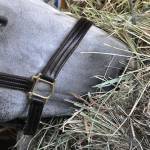Advantages of High-Fiber Diets for Horses

The low enzyme activity in the saliva and in the small intestine for the digestion of starch and sugars tells us that the horse’s main energy source is not supposed to be sugars. Instead, the primary energy source should be volatile fatty acids (VFAs) from microbial fermentation in the large intestine. These VFAs are either used directly as fuel in the cells or they are transformed to other energy molecules, such as glucose. Longer chain fatty acids can also be derived from dietary fat, which is absorbed mainly from the small intestine.
The horse best prepared for demanding tasks, such as endurance races, is the horse with a high microbial activity from beneficial microbes in the hindgut. Ideally, 60-75% of the horse’s energy requirement should come from hindgut fermentation. The lower value is sufficient for a racehorse, and the higher value for the endurance horse. Owners can regulate the proportion of energy from the hindgut by the fiber content in the feed. If you have less than 15% crude fiber in the diet, the horse’s digestive tract functions like that of a pig or a human. With a high fiber content, the horse becomes more dependent on microbial fermentation and VFAs from the hindgut.
High fiber content in the feed can also have a microbe-sparing effect in the hindgut. When the ingesta passes from the large colon to the small colon, fluid with a high microbial content is squeezed from the solids and re-enters the large colon. This effect is more pronounced when the fiber content in the feed is high. When the fluid is separated from the solids, peptidase, water soluble molecules, and small undigested particles are also recycled into the large intestine for further digestion. In that way the fecal loss of valuable nutrients is much less in horses fed fiber-rich feeds. Indigestible solids will leave the horse quickly and in this way stimulate the appetite.
This fluid barrier also prevents water and electrolyte losses via the feces. If the horse is properly fed, the large intestine serves as a reservoir for water and electrolytes. If the diet is rich in starch that escapes enzymatic digestion in the small intestine, starch particles will hold the water in the large intestine due to osmosis. Thus it will be difficult to use the water in the large intestine to compensate for the dehydration that always occurs during an endurance race.
In a Swedish experiment, four horses received equal amounts of energy from either grass hay (1.5 kg/100 kg BW) or grass hay (0.7 kg/100 kg BW) and oats (0.5 kg/100 kg BW). Blood, feces, and urine were collected for analysis. The retained sodium (in percent of the intake) was significantly higher for horses getting the high-fiber feed. The retention of potassium was the same between the two diets. Where sodium goes, water goes. Therefore, it can be concluded that a high-fiber diet also increases water reservoir in the large intestine. The blood samples showed a post-feeding increase in serum-sodium when the horses were fed oats. As the sodium peak occurred one hour after feeding, we can assume that the sodium was absorbed in the small intestine. This did not happen when the horses were fed hay. The oats have a higher concentration of starch that is digested to glucose by enzymes in the small intestine.
From research conducted with pigs, we know of a glucose-sodium coupled uptake. This means that when glucose is absorbed through the intestinal wall, sodium is carried along with the glucose molecule. Because of this coupling, which is positive in a piglet with diarrhea, sodium is absorbed and enters the blood. Unfortunately this sodium, if it is not needed for metabolism, is immediately excreted in the urine. Orally given electrolytes between meals probably suffer the same fate. At least we can assume this if the electrolyte mixture also contains glucose. If the sodium escapes uptake in the small intestine, as with the hay diet, we create a buffer of electrolytes in the large intestine, which can be used in times of electrolyte depression. This is why retained sodium is higher when horses get a high-fiber diet.
This information was taken from a longer lecture by Per Spangfors, a Swedish veterinarian who spoke at a Kentucky Equine Research nutrition conference.








